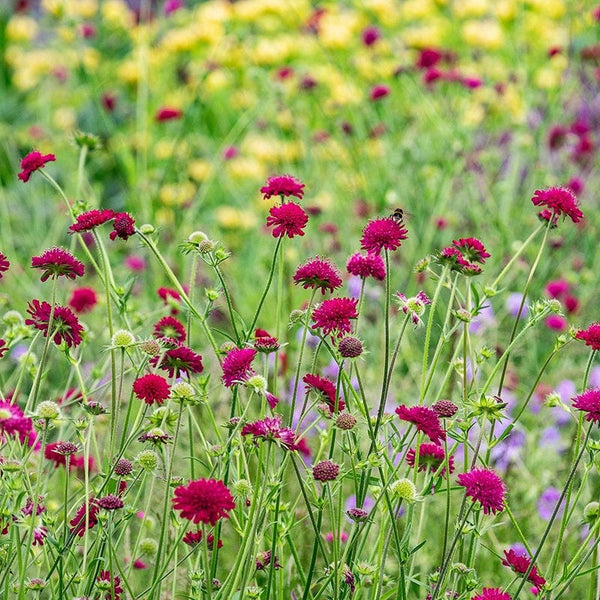In a garden full of bold and showy flowers, Knautia macedonica offers a more delicate charm with its finely-cut foliage and rich crimson blooms. Though often overshadowed by more common border perennials, this plant has earned a loyal following among gardeners who prize its extended flowering season, cottage-garden style, and appeal to bees and butterflies.
Native to the Balkans and parts of Eastern Europe, Knautia thrives in a variety of conditions and pairs wonderfully with ornamental grasses, echinacea, and salvia. It’s perfect for informal borders, naturalistic plantings, and wildflower-inspired gardens.

Portrait of the Knautia
Part of the Caprifoliaceae family (the same as honeysuckle), Knautia macedonica is a herbaceous perennial known for its long stems and rich, pincushion-like flowers. Though it shares a family connection with scabiosa (its flowers may remind you of them), knautia is a distinct genus.
This plant is appreciated for both its informal structure and the constant wave of blooms it delivers from early summer through fall.
Foliage and Form
The plant forms a low mound of soft, lobed green leaves at the base, with slender, wiry stems that rise above to bear flowers.
- Height: 60–90 cm (2–3 ft)
- Spread: 30–45 cm (1–1.5 ft)
- Form: Airy, upright, loose and meadow-like
Blooms and Fragrance
The dark magenta to burgundy-red flowers resemble miniature pincushions and attract bees, hoverflies, and butterflies throughout the warm months.
- Bloom Time: Late spring through early autumn
- Color: Crimson, wine-red, dark pink
- Fragrance: Mild to none
The Right Time to Plant and Care for Knautia
Knautia can be planted in spring or early fall. Deadheading will prolong blooming, and it benefits from a light pruning in midsummer if it begins to look scraggly.
| Month | Planting | Flowering | Pruning |
|---|---|---|---|
| January | ❌ | ❌ | ❌ |
| February | ❌ | ❌ | ❌ |
| March | ✅ (indoors or divisions) | ❌ | ✅ (trim back winter stems) |
| April | ✅ | ❌ | ✅ (early shaping) |
| May | ✅ | ✅ (start) | ❌ |
| June | ❌ | ✅ | ✅ (deadhead regularly) |
| July | ❌ | ✅ | ✅ (optional light trim) |
| August | ❌ | ✅ | ✅ |
| September | ✅ | ✅ | ✅ |
| October | ✅ (mild zones) | ✅ (late) | ✅ |
| November | ❌ | ❌ | ✅ (cut back spent stems) |
| December | ❌ | ❌ | ❌ |
✅ = Recommended ❌ = Not advised
Watering, Sunlight, Indoor vs Outdoor, and Temperature
Watering
Knautia is drought-tolerant once established, making it suitable for xeriscaping or low-maintenance beds.
- Keep soil moist during establishment.
- Once mature, water only during prolonged dry spells.
Sunlight
Full sun is ideal for best flowering. Light shade is tolerated, but bloom production may be reduced.
- Minimum: 6 hours of sunlight
- Maximum: Full day sun exposure encouraged
Indoor vs Outdoor
This is strictly an outdoor plant, best suited to borders, gravel gardens, or meadow-style plantings.
- Not viable as an indoor potted plant
- Can be grown in large containers outdoors
Temperature
- Hardiness: USDA Zones 4–8
- Preferred Range: 15–27°C (60–80°F)
- Cold Tolerance: Can survive hard frosts and snowy winters
Ideal Soil Conditions for Growing Knautia
| Soil Feature | Optimal Condition | Why It Matters |
|---|---|---|
| Soil Type | Loamy, sandy, or even gravelly | Encourages drainage and reduces root rot risk |
| Texture | Loose and well-draining | Supports deep, healthy root growth |
| Drainage | Excellent | Poor drainage can lead to root and stem rot |
| Moisture | Moderate to dry | Mimics natural habitat in meadows and slopes |
| Soil pH | Neutral to slightly alkaline (6.5–7.5) | Suitable for Mediterranean-style plant mixes |
Common Problems & Solutions
| Issue 🐾 | Symptoms 🔍 | Solutions 🛠️ |
|---|---|---|
| Powdery Mildew 🌫️ | White film on leaves | Increase spacing and air flow; treat with sulfur spray |
| Spindly Growth 🌿 | Leggy stems with fewer flowers | Cut back by one-third midseason |
| Aphids 🐜 | Curling leaves or sticky residue | Spray with insecticidal soap or hose off |
| Root Rot 💧 | Wilting despite moist soil | Improve drainage; avoid overwatering |
With its continuous bloom cycle, minimal care requirements, and charming wildflower look, Knautia macedonica is a delightful addition to any pollinator or cottage garden. It offers color, movement, and texture that pairs effortlessly with a range of sun-loving perennials.